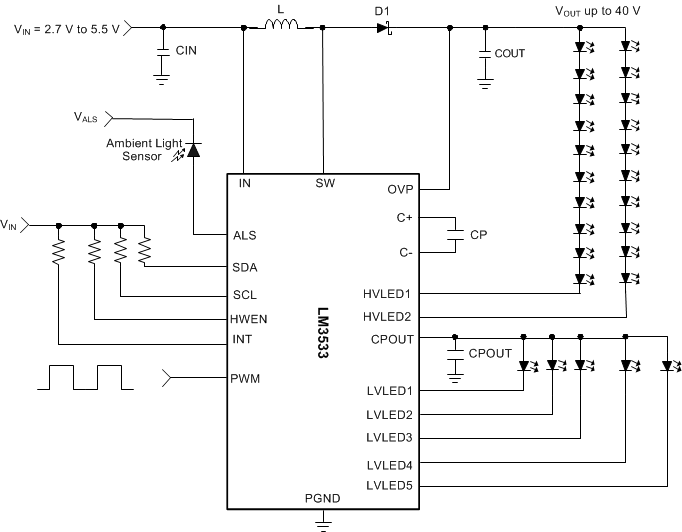ZHCSE58C April 2012 – September 2015 LM3533
PRODUCTION DATA.
- 1 特性
- 2 应用范围
- 3 说明
- 4 修订历史记录
- 5 Pin Configuration and Functions
- 6 Specifications
-
7 Detailed Description
- 7.1 Overview
- 7.2 Functional Block Diagram
- 7.3 Feature Description
- 7.4
Device Functional Modes
- 7.4.1 High-Voltage Boost Converter
- 7.4.2 Integrated Charge Pump
- 7.4.3 LED Current Mapping Modes
- 7.4.4 LED Current Ramping
- 7.4.5 Brightness Register Current Control
- 7.4.6 PWM Control
- 7.4.7 ALS Current Control
- 7.4.8
ALS Functional Blocks
- 7.4.8.1 ALS Input
- 7.4.8.2 Analog Output Ambient Light Sensors (ALS Gain Setting Resistors)
- 7.4.8.3 PWM Output Ambient Light Sensors (Internal Filtering)
- 7.4.8.4 Internal 8-Bit ADC
- 7.4.8.5 ALS Averager
- 7.4.8.6 Initializing the ALS
- 7.4.8.7 ALS Algorithms
- 7.4.8.8 ALS Rules
- 7.4.8.9 Direct ALS Control
- 7.4.8.10 Up-Only Control
- 7.4.8.11 Down-Delay Control
- 7.4.9 Pattern Generator
- 7.4.10 Fault Flags/Protection Features
- 7.5 Programming
- 7.6 Register Maps
- 8 Application and Implementation
- 9 Power Supply Recommendations
- 10Layout
- 11器件和文档支持
- 12机械、封装和可订购信息
1 特性
- 驱动两个并联高电压发光二极管 (LED) 灯串为显示屏和键盘提供照明
- 能够支持高达 40V 输出电压的高压灯串,并且效率高达 90%
- 每灌电流高达 30mA(背光和指示灯)
- 采用 8 位可编程背光代码实现 14 位指数调光
- 可选择带有 128 个可编程增益设置电阻的模拟环境光传感器 (ALS) 输入或者带有内部低通滤波器的脉宽调制 (PWM) ALS 输入
- 针对内容可调亮度控制的 PWM 输入
- 五个用于指示器 LED 的低压电流阱
- 用于提高效率和 VIN 工作范围的集成电荷泵
- 内部图案生成引擎
- 完全可编程 LED 分组和控制
- 4 个可配置过压保护阈值(16V,24V,32V 和 40V)
- 500kHz 和 1MHz 可编程开关频率
- 27mm2 总体解决方案尺寸
2 应用范围
- 用于智能手机照明的电源
- 显示器、键区和指示器照明
- RGB 指示器驱动器
3 说明
LM3533 是一款用于智能手机内背光、键盘和指示器 LED 的完整电源。 高压电感升压转换器为用于显示屏背光和键盘功能的两个串联 LED 灯串供电(HVLED1 和 HVLED2)。 集成电荷泵为五个低电压指示器 LED 电流阱(LVLED1 至 LVLED5)提供偏置。 所有低压电流阱均具有一种可编程图案生成器,可针对各种闪烁图案对其输出电流进行调制。
附加功能包括用于内容可调背光控制 (CABC) 的脉宽调制 (PWM) 控制输入以及一个带有 8 位内部模数转换器 (ADC) 的环境光传感器 (ALS) 接口,这两种功能可根据环境光照条件自动调节电流。 PWM 和 ALS 输入均可用于控制任何高电压或低电压电流阱。
LM3533 完全可由一个 I2C 兼容接口进行编程。 该器件采用
20 引脚芯片尺寸球状引脚栅格阵列 (DSBGA) 封装,其工作输入电压范围为 2.7V 至 5.5V,工作温度范围为 -40°C 至 +85°C。
器件信息(1)
| 部件号 | 封装 | 封装尺寸(最大值) |
|---|---|---|
| LM3533 | DSBGA (20) | 2.04mm x 1.78mm |
- 要了解所有可用封装,请见数据表末尾的可订购产品附录。
典型应用电路
